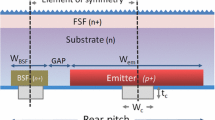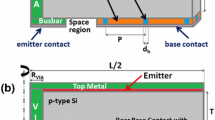Abstract
In this research, modeling was performed to optimize the grid of the front surface of a solar cell with the passivated emitter and rear contact (PERC) structure by considering the recombination characteristics. The front surface recombination velocity can be reduced in two main ways. The first method is to reduce the emitter Auger recombination by lowering the surface doping concentration during emitter formation, and the second method is to reduce the recombination that occurs at the surface when the electrode and the silicon are in contact, which is called metal-induced recombination and is represented by J0.metal. Because J0.metal increases in proportion to the area of the front electrode, minimizing the finger width and number by optimizing the electrode design is important. Therefore, the front electrode grid should be designed considering the emitter characteristics, J0.metal, according to the number of fingers and the resistance. In this research, the front grid of the solar cell was optimized via modeling using equations to calculate the number of fingers and the resistance. According to the finger width, the number of busbars, the sheet resistance, the aspect ratio, and the number of fingers corresponding to the maximum efficiency were identified. As a result, this modeling enabled us to optimize the front grid to the desired conditions, and we found that an increase in the number of busbars plays an important role in improving the efficiency of solar cells. In addition, the efficiency change with increasing number of busbars can be seen to be affected by the width of the finger and the resolution of the printed finger rather than the aspect ratio.
Similar content being viewed by others
References
A.W. Blakers et al., Appl.Phys. Lett. 55, 1363 (1989).
M.A. Green et al., IEEE Trans. Electron Devices 37, 331 (1990).
S. Zhang et al., Energies 12, 1168 (2019).
F. Ye et al., Sol. Energy Mater. Sol. Cells 190, 30 (2019).
S. Zhang et al., Energies 12, 416 (2019).
W. Chena, R. Liu, Q. Zeng and L. Zhou, Sol. Energy 184, 508 (2019).
S. Joonwichien et al., Sol. Energy Mater. Sol. Cells 186, 84 (2018).
H. Huang et al., Sol. Energy Mater. Sol. Cells 161, 14 (2017).
K. Srinivasan and A. Kottantharayil, Sol. Energy Mater. Sol. Cells 197, 93 (2019).
S. Gatz, J. Müller, T. Dullweber and R. Brendel, Energy Procedia 27, 95 (2012).
J. M. Yacob Ali et al., Sol. Energy Mater. Sol. Cells 192, 117 (2019).
Y. F. Zhuang et al., Sol. Energy Mater. Sol. Cells 193, 379 (2019).
B. Vermang et al., Prog. Photovolt.: Res. Appl. 20, 269 (2012).
J. H. Lee et al., Curr. Appl. Phys. 19, 683 (2019).
C. H. Hsu et al., Surf. Coat. Technol. 358, 968 (2019).
J. H. Lai et al., IEEE J. Photovolt. 1, 16 (2011).
M. Xie, X. Yu, X. Qiu and D. Yang, Sol. Energy Mater. Sol. Cells 191, 350 (2019).
J. M. Hwang, J. Appl. Phys. 125, 173301 (2019).
Z. Suxiang et al., Appl. Surf. Sci. 290, 66 (2014).
Z. Xin et al., Sol. Energy Mater. Sol. Cells 191, 164 (2019).
H. Hannebauer et al., Phys. Status Solidi RRL 8, 675 (2014).
T. Dullweber et al., in Proceedings of the 29th European Photovoltaic Solar Energy Conference and Exhibition (Amsterdam, The Netherlands, September 22–26, 2014).
A. Metz et al., Sol. Energy Mater. Sol. Cells 120, 417 (2014).
A. Goetzberger, J. Knobloch and B. Voss, Crystalline Silicon Solar Cells (Wiley, Chichester, 1998).
A. Cuevas and M. Balbuena, Conference Record of the 20thIEEE Photovoltaic Specialists Conference (Las Vegas, NV, USA, September 26–30}, 1988).
E. Demesmaeker et al., Conference Record of the 22thIEEE Photovoltaic Specialists Conference (Las Vegas, NV, USA, October 7–11, 1991).
A. Cuevas and D. A. Russell, Prog. Photovolt.: Res. Appl. 8, 603 (2000).
A. Mette, PhD Thesis, Freiburg im Breisgau, 2007.
M. A. Green, Solar Cells: Operating Principles, Technology and System Application (University of NSW, Kensington, 1992).
Y. Yang et al., Prog. Photovolt.: Res. Appl. 20, 490 (2012).
L. Castañer and S. Silvestre, Modelling photovoltaic systems using PSpice (John Wiley & Sons, Hoboken, NJ, 2002).
B. Galiana, C. Algora and I. Rey-Stolle, Sol. Energy Mater. Sol. Cells 90, 16 (2006).
A. Zekry and A. Al-Mazroo, IEEE Trans. Electron Devices 43, 5 (1996).
B. Fischer, PhD Thesis, Universität Konstanz, 2003.
M. M. Hilali, PhD Thesis, Georgia Institute of Technology, 2005.
G. Schubert, PhD Thesis, Universität Konstanz, 2006.
S. Meier et al., 2018 IEEE 7th World Conference on Photovoltaic Energy Conversion (WCPEC) (A Joint Conference of 45th IEEE PVSC, 28th PVSEC & 34th EU PVSEC) (Waikoloa Village, HI, USA, June 10–15, 2018).
D. Inns and D. Poplasvskyy, 42nd IEEE PVSC (New Orleans, June 14–19, 2015).
T. Fellmeth et al., Energy Procedia 8, 115 (2011).
A. Edler et al., Prog. Photovolt.: Res. Appl. 23, 620 (2015).
Acknowledgments
This work was conducted under the New and Renewable Energy Technology Development Program of the Korea Institute of Energy Technology Evaluation and Planning (KETEP) through a grant funded by the Ministry of Knowledge Economy, Korea (Project No. 20183030019460), and by the Technology Development Program to Solve Climate Changes of the National Research Foundation (NRF) funded by the Ministry of Science, ICT & Future Planning (2017M1A2A2086911).
Author information
Authors and Affiliations
Corresponding authors
Rights and permissions
About this article
Cite this article
Jeong, M.S., Min, K.H., Choi, S. et al. Dependence of the Optimization of the Front Grid Design in Passivated Emitter and Rear Contact c-Si Solar Cells on the Finger Width and the Aspect Ratio. J. Korean Phys. Soc. 76, 774–780 (2020). https://doi.org/10.3938/jkps.76.774
Received:
Revised:
Accepted:
Published:
Issue Date:
DOI: https://doi.org/10.3938/jkps.76.774




